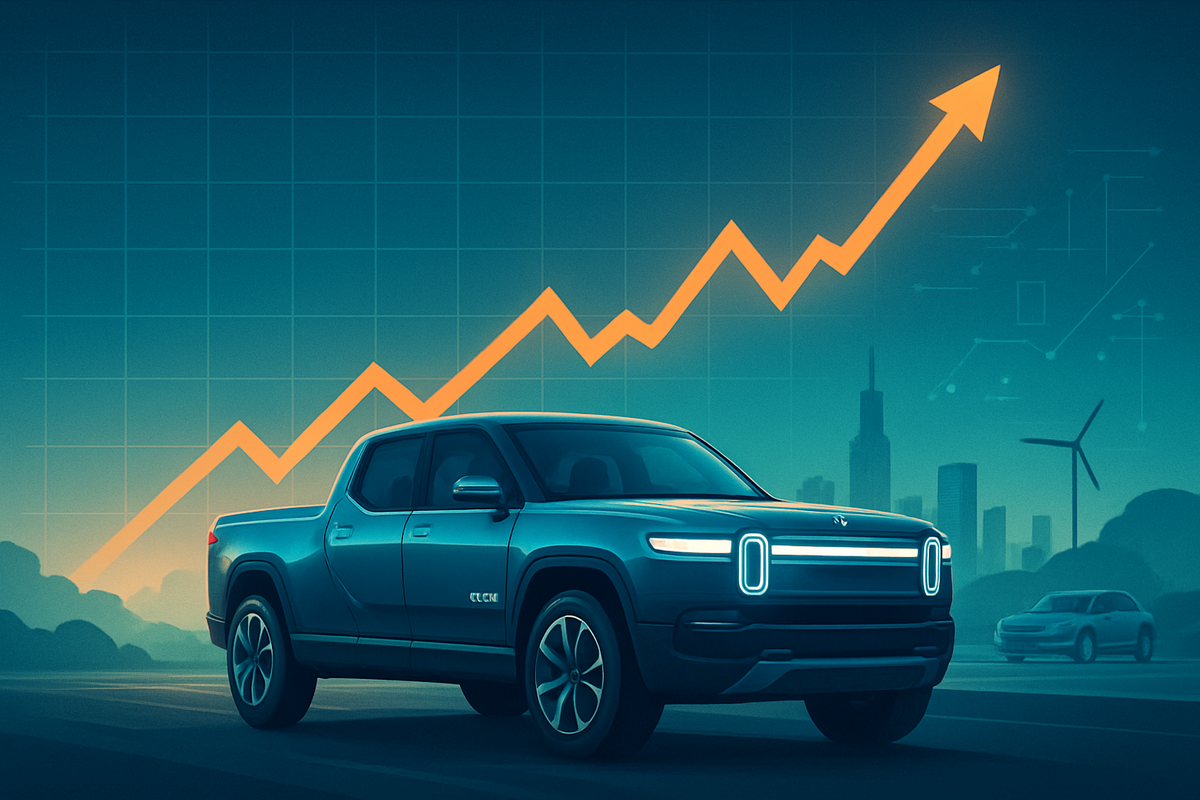
Rivian Automotive (NASDAQ: RIVN) witnessed a significant surge in its stock price today, November 10, 2025, with shares climbing by over 23%. This impressive performance was primarily driven by the company's stronger-than-expected third-quarter (Q3) 2025 financial results, which notably included its first-ever consolidated gross profit. The positive earnings report, coupled with the announcement of a new, highly incentivized long-term compensation package for CEO RJ Scaringe, has injected a fresh wave of optimism into the electric vehicle (EV) manufacturer and the broader market.
The immediate implications are clear: renewed investor confidence in Rivian's operational efficiency and strategic direction. Achieving a gross profit in a challenging EV market signals a potential turning point for the company, suggesting that its aggressive cost-reduction strategies and diversified revenue streams are beginning to bear fruit. For the wider market, Rivian's resilience could serve as a positive indicator for other EV pure-plays, demonstrating that growth and even profitability are attainable with strong execution, despite industry headwinds.
Detailed Coverage: A Quarter of Surprises and Strategic Moves
Rivian's Q3 2025 financial results, released on November 4, 2025, presented a compelling narrative of progress. The company reported consolidated revenues of $1.56 billion to $1.6 billion, comfortably surpassing Wall Street's expectations of $1.5 billion. Automotive revenues alone grew by 47% year-over-year to $1.14 billion, propelled by increased vehicle deliveries and higher average selling prices. Crucially, the software and services segment saw an astounding 324% increase, contributing $416 million in revenue, partly due to its joint venture with Volkswagen.
The most significant highlight was the achievement of a consolidated gross profit of $24 million. This defied analyst expectations of a $64 million loss and marked a dramatic improvement from the $392 million loss in Q3 2024, effectively ending two consecutive quarters of losses. While automotive operations still incurred a gross loss of $(130) million, this was offset by a robust $154 million gross profit from software and services. Rivian delivered 13,201 vehicles in the quarter, its highest quarterly total for 2025, and narrowed its adjusted earnings per share (EPS) loss to -$0.65, better than the anticipated -$0.74. The company exited Q3 with a strong liquidity position of $7.7 billion, including $7.1 billion in cash and short-term investments, providing a solid foundation for future initiatives. A notable factor contributing to the strong Q3 deliveries was a rush by consumers to purchase EVs before the $7,500 federal tax credit expired at the end of September 2025.
Adding to the positive sentiment, news emerged between November 8 and November 10, 2025, regarding the approval of a new, substantial performance-based compensation package for CEO RJ Scaringe. Modeled after Tesla's (NASDAQ: TSLA) executive compensation structure, this package could be valued at up to $4.6 billion over the next decade if ambitious performance targets are met by 2032. The plan includes stock options for up to 36.5 million shares, contingent on achieving share price goals ranging from $40 to $140, alongside operational profit and cash flow milestones. This move signals the board's strong confidence in Scaringe's leadership and a clear focus on long-term shareholder value creation.
The stock surge on November 10, 2025, was a direct response to this confluence of positive financial news and strategic leadership incentives. Rivian (NASDAQ: RIVN) shares soared by over 23% to 25%, reaching approximately $16.50, and saw an unusually high trading volume, with 191,958 call options purchased. While some analysts maintained a cautious stance, the overall market reaction indicated a significant shift in investor perception, viewing the positive gross profit as a potential inflection point for the company's fundamentals.
Winners and Losers: A Ripple Through the EV Ecosystem
Rivian's strong performance and positive Q3 2025 results are sending ripples throughout the electric vehicle ecosystem, creating potential winners and losers among public companies.
Potential Winners:
- EV Battery and Component Suppliers: Key suppliers such as Samsung SDI (KRX: 006400), a major battery cell provider, stand to gain directly from increased Rivian production and sales. Similarly, OPmobility (EPA: POM), which assembles bumpers for the upcoming R2 crossover, will benefit from its anticipated volume. Other Tier 1 suppliers providing critical components like braking systems and electronics would also see increased orders, indicating a more stable and growing demand.
- Amazon.com (NASDAQ: AMZN): As a significant investor in Rivian and its primary partner for electric delivery vans (EDVs), Amazon directly benefits from Rivian's improved financial health and operational stability. A thriving Rivian validates Amazon's investment and strategy for decarbonizing its logistics fleet, ensuring a reliable supply of EDVs and potentially appreciating its stake in the company.
- Volkswagen AG (FWB: VWAGY): The $5.8 billion joint venture with Volkswagen, aimed at leveraging Rivian's software-defined vehicle platform, receives strong validation from Rivian's positive results. This partnership is crucial for Volkswagen's EV software development and could open new recurring revenue streams for Rivian through licensing.
- Broader EV Market Sentiment: A strong performance from a prominent EV pure-play like Rivian can inject fresh optimism into the overall electric vehicle sector. This could attract more investment and positively influence investor sentiment towards other EV manufacturers, particularly those demonstrating a clear path to profitability and innovation.
Potential Losers or Companies Facing Increased Pressure:
- Direct EV Competitors (Trucks and SUVs): Ford Motor Company (NYSE: F), with its F-150 Lightning and Mustang Mach-E, and General Motors (NYSE: GM), with its Silverado EV and Blazer EV, are direct competitors to Rivian's R1T, R1S, and the upcoming R2. Rivian's success could intensify competition, forcing these legacy automakers to accelerate their EV rollouts, refine pricing strategies, and potentially impact their market share and profitability in key segments. Tesla (NASDAQ: TSLA), while dominant, also faces increased competition from Rivian's Cybertruck and the upcoming R2, which targets segments where Tesla is expanding.
- Other EV Startups: Companies like Lucid Group (NASDAQ: LCID), which also operate in the capital-intensive EV startup space, might find themselves under increased scrutiny to demonstrate similar progress toward production targets and profitability as Rivian. A strong Rivian could draw investor focus and capital away from other startups facing significant production and financial challenges.
- Traditional Automakers with Slower EV Transitions: Companies perceived as slower in their EV transition, such as Toyota Motor Corporation (NYSE: TM), Honda Motor Co. (NYSE: HMC), and Stellantis N.V. (NYSE: STLA), could face mounting pressure. Rivian's success reinforces the market's shift towards electrification, compelling these automakers to accelerate their investments in EV technology, production, and infrastructure to remain competitive.
Wider Significance: Navigating an Evolving Industry
Rivian's Q3 2025 performance and subsequent stock surge arrive at a pivotal moment for the electric vehicle industry, which is undergoing an "EV industry reset." This period is characterized by slowing demand growth, high interest rates, and intensifying competition, leading some traditional automakers to reconsider or scale back their EV production plans. In this challenging environment, Rivian's ability to achieve positive gross profit and maintain delivery guidance signals a remarkable resilience and strategic effectiveness.
This event underscores a critical industry shift: the paramount importance of profitability over unchecked growth. Rivian's aggressive focus on cost reduction, particularly for its upcoming R2 platform which aims for a 45% material cost reduction, reflects a broader trend where EV manufacturers must prioritize efficiency and margin improvement as the market matures. This strategic pivot towards sustainable financial models is becoming a defining characteristic of successful players in the evolving EV landscape.
The ripple effects on competitors are substantial. For other EV startups, Rivian's progress sets a higher bar for demonstrating a viable path to profitability. For established automakers like Ford and General Motors, Rivian's continued strength in premium electric trucks and SUVs validates these niches and compels them to refine their own EV strategies, particularly in terms of product development and cost efficiency. The Volkswagen partnership is also a significant development, as it could serve as a blueprint for future licensing deals, highlighting the growing trend of collaboration and technology sharing within the automotive sector to accelerate EV adoption and software development.
From a regulatory and policy standpoint, Rivian's Q3 performance highlights the dual impact of government incentives and trade policies. The Q3 delivery surge, partly fueled by the expiring $7,500 federal EV tax credit, demonstrates the strong influence of such policies on consumer demand. The anticipated decline in Q4 deliveries due to this expiration underscores the need for stable and predictable policy support for sustained EV adoption. Conversely, recent policy adjustments by the Commerce Department, extending a 3.75% MSRP offset for Section 232 automotive tariffs until 2030 and expanding eligible parts, are expected to significantly reduce Rivian's per-vehicle tariff costs, positively impacting profitability. The diminished value of Zero-Emission Vehicle (ZEV) credits also indicates a maturing regulatory landscape where such credits may play a less pivotal role in manufacturers' financial strategies.
Historically, Rivian's trajectory draws parallels to Tesla's early growth phases, where scaling production, reducing costs for mass-market vehicles, and exploring licensing opportunities were key to success. Tesla's ability to lead in battery technology and scale production eventually led to high valuations and ecosystem expansion. Rivian's R2 could be a similar catalyst. The broader EV market's volatility also echoes tech industry "hype cycles," where promising startups see initial surges followed by corrections. However, history also shows that companies with strong innovation and adaptable strategies, like Apple (NASDAQ: AAPL) in contrast to Nokia, are better positioned to navigate dynamic market landscapes and secure long-term success.
What Comes Next: Navigating Growth and Profitability
Following its pivotal Q3 2025 results, Rivian stands at a crucial juncture, with both significant opportunities and formidable challenges ahead. The coming months and years will define its trajectory in the rapidly evolving EV market.
Short-Term Possibilities: In the immediate future, Rivian is poised to capitalize on its improved financial narrative. The positive gross profit and better-than-expected revenue are likely to sustain investor confidence, potentially stabilizing or further increasing its stock value. The company's continued focus on cost reduction, particularly in automotive cost of goods sold per unit, is expected to enhance unit economics for its current R1 models. A critical short-term catalyst is the upcoming launch of the R2 in the first half of 2026. By commencing R2 production at its existing Normal, Illinois plant, Rivian aims to accelerate time to market and reduce initial capital outlay by over $2.25 billion, with early reservations already indicating strong demand.
Long-Term Possibilities: The long-term outlook for Rivian hinges on its strategic expansion into the more accessible mass market with the R2 and subsequent R3 models. The R2 SUV, targeting a $45,000 price point, is designed to drive significant volume growth and achieve positive unit economics by late 2026. Following the R2, the even more affordable R3 crossover and its R3X variant are slated for launch, likely in 2028 or 2029, with production anticipated at the Georgia manufacturing facility, expected to open in 2028. This expansion into lower price points is essential for Rivian to scale beyond its premium niche. Another significant long-term driver is the multi-billion-dollar joint venture with Volkswagen AG (FWB: VWAGY). Volkswagen plans to invest up to $5.8 billion in Rivian and the joint venture by 2027, aiming to integrate Rivian's advanced electrical architecture and software technology into future Volkswagen models starting in 2027. This could create a substantial, recurring revenue stream for Rivian, positioning it as a key technology provider in the software-defined vehicle (SDV) landscape.
Strategic Pivots and Adaptations Required: To achieve its ambitious goals, Rivian must execute several strategic pivots. Efficiently scaling R2 production at the Normal plant without compromising quality will be paramount. The eventual construction and operationalization of the Georgia plant for R3 production will require careful capital and resource management. Continued aggressive cost optimization across manufacturing, design, and the supply chain will be essential to sustain profitability, especially for the lower-margin R2 and R3 models. Balancing the expansion into the mass market with its premium brand identity will also be a delicate act.
Market Opportunities and Challenges: Opportunities include the projected continued growth of the global EV market, the underserved mid-market segment that the R2 targets, and Rivian's potential leadership in SDV technology through the Volkswagen partnership. Challenges include intensifying competition from both established automakers and other startups, policy uncertainty and potential subsidy cuts impacting consumer demand, the capital-intensive nature of EV manufacturing, and ongoing supply chain volatility.
Potential Scenarios: In a best-case scenario, Rivian successfully executes the R2 launch, achieves high production volumes and favorable unit economics, and its Volkswagen partnership flourishes, leading to sustained profitability and a significant recovery in its stock price. A moderate scenario might see a successful R2 launch but face some production challenges and intense mid-market competition, leading to a slower path to profitability. In a worst-case scenario, the R2 launch encounters significant delays or fails to attract sufficient demand, cost reduction efforts prove insufficient, and the Volkswagen partnership underperforms, resulting in continued stock pressure and limited market share.
Wrap-up: A Critical Juncture for Rivian
Rivian's (NASDAQ: RIVN) stock surge on November 10, 2025, following its positive Q3 2025 results, marks a critical juncture for the company and the broader electric vehicle market. The achievement of its first-ever consolidated gross profit, coupled with strong revenue growth and strategic partnerships, has instilled a renewed sense of optimism among investors. This quarter's performance suggests that Rivian's aggressive focus on cost reduction and diversification into software and services is beginning to yield tangible financial benefits, positioning it for a more sustainable future.
Key Takeaways: The primary takeaway is Rivian's demonstrated ability to improve operational efficiency and move towards profitability in a challenging market. The substantial contribution from the Volkswagen joint venture and the growth in software services highlight the importance of diversified revenue streams beyond vehicle sales. The upcoming R2 launch is paramount, representing Rivian's strategic pivot to expand its addressable market and achieve greater scale.
Assessing the Market Moving Forward: While the immediate market reaction is positive, the broader EV landscape remains dynamic and competitive. The industry is grappling with an "EV industry reset," characterized by fluctuating demand, high interest rates, and policy uncertainties. Rivian's resilience in this environment could serve as a beacon for other EV pure-plays, but it also intensifies the pressure on all manufacturers to innovate, reduce costs, and execute flawlessly. The expiration of federal tax credits underscores the sensitivity of consumer demand to government incentives, a factor that will continue to influence market dynamics.
Final Thoughts on Significance and Lasting Impact: Rivian's Q3 results are profoundly significant, validating its strategic direction and offering a clearer, albeit still challenging, path to sustained profitability. The success of the R2 launch in 2026 will be the ultimate determinant of Rivian's ability to transition from a niche premium brand to a major mass-market player. Its lasting impact will depend on its capacity to execute on production ramp-up, manage supply chain complexities, and leverage its technological advancements and partnerships to carve out a dominant position in the evolving EV landscape.
What Investors Should Watch For in Coming Months: Investors should closely monitor several key indicators:
- R2 Production and Launch: The successful and timely ramp-up of R2 production and market reception will be paramount.
- Sustained Gross Profit and Path to Net Profitability: Look for continued improvements in gross margins and a clear trajectory towards positive adjusted EBITDA (targeted by 2027) and ultimately, net profitability.
- Cost Management: Further evidence of cost efficiencies across manufacturing and operations will be crucial.
- Demand Trends: Observe sales figures for existing R1 models and early reservation numbers for the R2 and R3 to gauge broader market acceptance.
- Volkswagen Partnership Progress: Monitor the evolution of the joint venture and its contribution to intellectual property licensing and revenue streams.
- External Factors: Keep an eye on developments in trade policy, tariffs, and EV incentives, which continue to significantly influence the cost structure and consumer demand.
While analyst sentiment remains cautiously optimistic, with some price targets suggesting limited upside from the recent surge, Rivian's positive Q3 results represent a critical step forward. The company's future hinges on its ability to execute its long-term growth strategy, particularly with the R2, and to solidify its financial footing in an increasingly competitive and volatile EV market.
This content is intended for informational purposes only and is not financial advice






